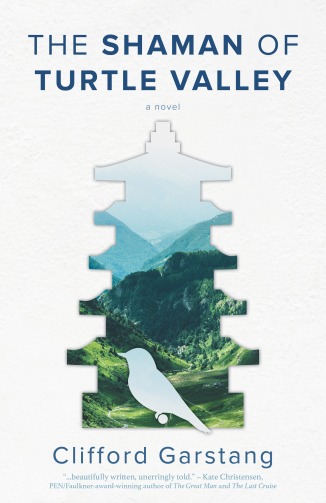 Clifford Garstang is the author of the forthcoming novel, The Shaman of Turtle Valley, the novel in stories, What the Zhang Boys Know, winner of the Library of Virginia Literary Award for Fiction, and the prize-winning short story collection In an Uncharted Country. About Garstang’s first book, Tim O’Brien, National Book Award-winning author of The Things they Carried, said, “In an Uncharted Country is an impeccably written, sumptuously imagined, and completely enchanting book of stories. . .” John Casey, National Book Award-winning author of Spartina, called What the Zhang Boys Know “a wonderful and haunting book.” Garstang is also the editor of Everywhere Stories: Short Fiction from a Small Planet, a three-volume anthology of short stories set around the world. Garstang’s work has appeared in Bellevue Literary Review, Blackbird, Cream City Review, Los Angeles Review, Tampa Review, and elsewhere, and has received Distinguished Mention in the Best American Series. He is also the co-founder and former editor of Prime Number Magazine.
Clifford Garstang is the author of the forthcoming novel, The Shaman of Turtle Valley, the novel in stories, What the Zhang Boys Know, winner of the Library of Virginia Literary Award for Fiction, and the prize-winning short story collection In an Uncharted Country. About Garstang’s first book, Tim O’Brien, National Book Award-winning author of The Things they Carried, said, “In an Uncharted Country is an impeccably written, sumptuously imagined, and completely enchanting book of stories. . .” John Casey, National Book Award-winning author of Spartina, called What the Zhang Boys Know “a wonderful and haunting book.” Garstang is also the editor of Everywhere Stories: Short Fiction from a Small Planet, a three-volume anthology of short stories set around the world. Garstang’s work has appeared in Bellevue Literary Review, Blackbird, Cream City Review, Los Angeles Review, Tampa Review, and elsewhere, and has received Distinguished Mention in the Best American Series. He is also the co-founder and former editor of Prime Number Magazine.
After receiving a BA in Philosophy from Northwestern University, Garstang served as a Peace Corps Volunteer in South Korea, where he taught English at Jonbuk University. He then earned an MA in English and a JD, magna cum laude, both from Indiana University, and practiced international law in Chicago, Los Angeles, and Singapore with one of the largest law firms in the United States. Subsequently, he earned a Master of Public Administration degree from Harvard University’s John F. Kennedy School of Government and worked for Harvard Law School’s Program on International Financial Systems as a legal reform consultant in Almaty, Kazakhstan. From 1996 to 2001, he was Senior Counsel for East Asia at the World Bank in Washington, D.C., where his work focused on China, Vietnam, Korea, and Indonesia. Subsequently he earned an MFA in Creative Writing from Queens University of Charlotte. He lives near Staunton, Va. Learn more at https://cliffordgarstang.com.
Curtis Smith: Congratulations on The Shaman of Turtle Valley. I’m always interested in a book’s journey in the indie press world. How did you end up with Braddock Avenue?
Clifford Garstang: To be honest, my agent shopped the book to the big publishers because that’s what you’re supposed to do, and we had some near misses with them. But all along I thought it was more of a small press book, so we eventually shifted gears and started looking at smaller presses. I knew Jeff Condran at Braddock and had met the other half of the team, Robert Peluso, at AWP a few years ago, and had also seen a couple of their titles that impressed me. I asked them to take a look at the manuscript and they liked it, so we were off and running.
CS: You’ve published two previous story collections with Press 53, but this is your first novel. How did the experience of writing a novel differ from a story collection? Did you change your process or mindset to tackle the project? Were there any unexpected challenges/rewards along the way?
CG: Although I always did intend the book to be a novel, it began in much the same way that my short stories do. I wanted to look at the challenges facing a young single father in an environment that was similar to the one I created in my first collection, In an Uncharted Country. As I do with stories, I just wrote until I figured out what my subconscious was telling me about the character and his situation. When that was more or less settled, I realized that a novel, unlike most stories, needs many dimensions, and while that doesn’t always require multiple points of view, one of the things I really like about writing short stories is the opportunity to inhabit different voices and perspectives. So, to find those additional dimensions to my story, I layered in the voices of the women in the main character’s life, starting with his wife, then his mother, and so on. Adding these voices really opened up the story for me and even took it in a different direction.
CS: The novel is told in a series of short passages. How did you decide on this structure? What does it bring that the typical longer, chapter-based structure wouldn’t offer?
CG: The shorter passages, interspersed with more traditional chapters, are primarily the perspectives of the five women in the main character’s life. They are rendered in first person, so we hear the women speak in their own voices, rather than seeing them only through his eyes. He is a man from a traditional environment who is being challenged at every turn by these women, and my hope is that the short passages, while not distracting from his narrative, will shed light on his flaws and blind spots.
CS: The novel addresses issues of culture clash and the walls and bridges we build. Can you look back and identify the seeds of this concept? I’m guessing it might be rooted in your own international experiences? Was there a trigger that took these ideas and then landed them in the forms of your characters?
CG: Hanging over my fireplace at my home in rural Virginia between two mountain ranges is a temple painting I acquired more than 40 years ago when I lived in Korea as a Peace Corps Volunteer. It depicts the Mountain God in a traditional pose, surrounded by a pine tree, a tiger, fungus, and other elements associated with Korean Shamanism. If there is one seed to the story, it might be seeing the Virginia mountains reflected in the glass protecting the painting and realizing that while both cultures are rather closed and isolated, there are numerous similarities that could draw them together, including the unhealed wounds inflicted by their respective civil wars.
CS: I’m always interested in a writer’s personal work habits. Some of us are planners, others dive right in—some sit down daily and others only when the inspiration hits. Can you share your routine and give us a glimpse of how the process works for you?
CG: I wish I were more of a planner, and every time I start a project I tell myself I’m going to be systematic about it: do an outline, give myself deadlines, and stick to my schedule. But I’m also terribly impatient and I’d rather be writing than planning, so once I have my basic idea I want to jump in and see where it goes. Having said that, I do consider writing my job, although one that I love, and that means keeping to a routine. So I’m at my desk (defined loosely—sometimes I abscond to a coffee shop to work and avoid the telephone) every morning with a goal of making progress on whatever the project is at the moment. Even if I only write one sentence that I’m happy with during that time, it’s still progress and it adds up. Afternoons are usually spent in other activities that support the writing—researching, promotion, blogging, etc.
 CS: Besides your writing, you’ve also acted as an editor, both for anthologies and for a literary journal. You also keep up a blog and website, and you annually publish a ranking of literary magazines based on the Pushcarts. First, thanks for that. It’s a great resource. And second, I’m assuming you do these things to be part of a greater literary community. Can you address the importance of and the rewards found in these endeavors outside your own writing?
CS: Besides your writing, you’ve also acted as an editor, both for anthologies and for a literary journal. You also keep up a blog and website, and you annually publish a ranking of literary magazines based on the Pushcarts. First, thanks for that. It’s a great resource. And second, I’m assuming you do these things to be part of a greater literary community. Can you address the importance of and the rewards found in these endeavors outside your own writing?
CG: Being part of the literary community through these other projects—the editing, the magazine rankings, the blogging, the book reviews I write—is, honestly, its own reward. Even if I never publish another book I feel like I’m part of a greater endeavor. And I do think it’s important for writers to help other writers. In no way is writing or publishing a zero-sum game or a competition. At the same time, though, these contributions have been beneficial to me. A lot of people know me through the editing work I’ve done or through the magazine rankings (although sometimes not by name—to a lot of people I’m just “Pushcart rankings guy”), which may lead them to discover my books. And while one’s writing has to stand on its own, the connections are invaluable in many ways.
CS: What’s next?
CG: I haven’t had time to think about it lately, but 2020 is going to be a big year, and not just because of the important Presidential election. Press 53 is bringing out another story collection for me in the spring, called House of the Ancients and Other Stories. Then in the fall, Regal House will publish my novel Oliver’s Travels. But my current writing is focused on a new novel, my most ambitious project yet. It’s a blended historical and contemporary novel set in Singapore, and while much of it is already written, I’ll be moving the words around a lot before I declare it finished.
Curtis Smith has published more than 100 stories and essays, and his work has appeared in or been cited by The Best American Short Stories, The Best American Mystery Stories, The Best American Spiritual Writing, The Best Short Fictions, and Norton Anthology New Microfictions. He’s worked with independent publishers to put out two chapbooks of flash fiction, three story collections, two essay collections, four novels, and a work of creative nonfiction. His latest books are Kurt Vonnegut’s Slaughterhouse-Five, Bookmarked (Ig Publishing) and the novel Lovepain (Braddock Avenue Books).
Great interview! I have to say, living in Richmond, VA, for a long time (and getting my MFA from VCU there) and seeing Garstang around the community–in person and online–I feel like I know him. But this interview got at things I didn’t know. Thanks for highlighting a wonderful leader in the literary community!
LikeLiked by 1 person
Pingback: JMWW Interview – CLIFFORD GARSTANG·
Pingback: Pre-publication Buzz – CLIFFORD GARSTANG·